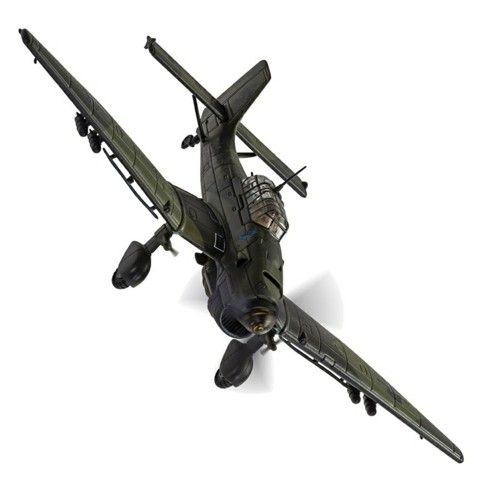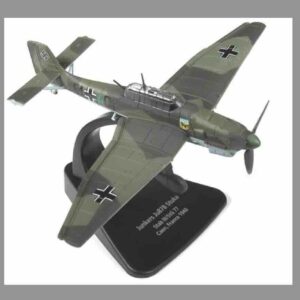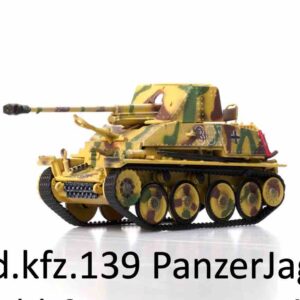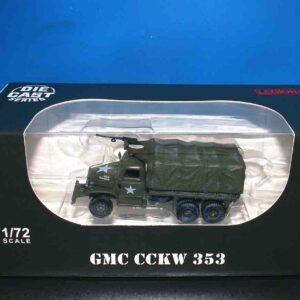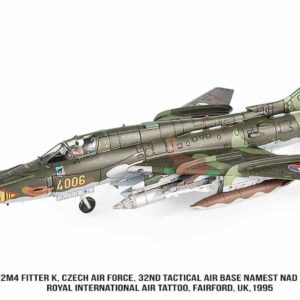Corgi – Junkers Ju 87B-2 Stuka , ‘J9+BL’ 9/StG.1 (Sturzkampfgeschwader 1) Luftwaffe , St. Pol France 1940
1,999 Kč
Skladem
Výrobce: CorgiMěřítko: 1:72Popis
- sběratelský model letadla Junkers Ju 87 B 1/72 - provedení:kovový model s plastovými částmi - model je v kvalitním provedení - součástí balení je stojánek
Junkers Ju 87 Stuka
Junkers Ju 87 – Stuka [štuka] (pozn. přezdívka Stuka pochází z německého slova das Sturzkampfflugzeug) sloužil během druhé světové války jako střemhlavý bombardovací letoun německé Luftwaffe. Model Ju 87 B-1 se osvědčil především na počátku války (v Polsku, Holandsku, Belgii i Francii), v bitvě o Británii však zcela zklamal. V roce 1941 se objevil model Ju 87 D-1 s řadou vylepšení (aerodynamika, pancéřování). Vzhledem k síle nepřátelských stíhaček byly postupně stuky nasazovány jako bitevní letouny (Ju 87 D-7). Jako protitankový letoun sloužil typ Ju 87G, vyzbrojen dvěma kanóny BK 37 ráže 37 mm.
The Junkers Ju 87 or Stuka (from Sturzkampfflugzeug, “dive bomber”) is a German dive bomber and ground-attack aircraft. Designed by Hermann Pohlmann, it first flew in 1935. The Ju 87 made its combat debut in 1937 with the Luftwaffe’s Condor Legion during the Spanish Civil War and served the Axis forces in World War II.
| Role | Dive bomber |
|---|---|
| Manufacturer | Junkers |
| Designer | Hermann Pohlmann |
| First flight | 17 September 1935 |
| Introduction | 1936 |
| Retired | 1945 (Luftwaffe) |
| Primary users | Luftwaffe Regia Aeronautica Royal Romanian Air Force Bulgarian Air Force |
| Number built | Estimated 6,500 |
General characteristics
- Crew: 2
- Length: 11.00 m (36 ft 1.07 in)
- Wingspan: 13.8 m (45 ft 3.30 in)
- Height: 4.23 m (13 ft 10.53 in)
- Wing area: 31.90 m² (343.37 ft²)
- Empty weight: 3,205 kg (7,086 lb)
- Loaded weight: 4,320 kg (9,524 lb)
- Max. takeoff weight: 5,000 kg (11,023 lb)
- Powerplant: 1 × Junkers Jumo 211D liquid-cooled inverted V12 engine, 1200 PS (1,184 hp (883 kW))
- Propellers: Three-blade Junkers VS 5 propeller, 1 per engine
- Propeller diameter: 3.4 m (11 ft 1.85 in)
Performance
- Never exceed speed: 600 km/h (373 mph)
- Maximum speed: 390 km/h @ 4,400 m (242 mph @ 13,410 ft)
- Cruise speed: 319 km/h (198 mph)
- Range: 500 km (311 mi) with 500 kg (1,100 lb) bomb load
- Service ceiling: 8,200 m (26,903 ft) with 500 kg (1,100 lb) bomb load
- Rate of climb: 2.3 m/s ()
Armament
- Guns: 2× 7.92 mm (.312 in) MG 17 machine gun forward, 1× 7.92 mm (.312 in) MG 15 machine gun to rear
- Bombs: Normal load = 1× 250 kg (550 lb) bomb beneath the fuselage and 4× 50 kg (110 lb), two bombs underneath each wing.
| Aircraft flown | |
|---|---|
| Fighter | Bf 109, Fw 190, Me 262 |
Sturzkampfgeschwader 1 (StG 1 – Dive Bomber Wing 1) was a Luftwaffe Dive bomber wing during World War II.
StG 1 was formed in May 1939 and remained active until October 1943, when it was renamed and reorganised into Schlachtgeschwader 1 (SG 1).
| Sturzkampfgeschwader 1 | |
|---|---|
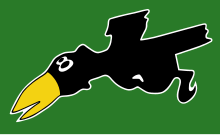
StG 1’s emblem
|
|
| Active | 1 May 1939 – 18 October 1943 |
| Country | |
| Branch | |
| Type | Dive bomber |
| Role | Close air support Offensive counter air Anti-tank warfare Air interdiction Maritime interdiction Bandenbekämpfung (anti-partisan) |
| Size | Air Force Wing |
| Engagements | World War II |
| Insignia | |
| Identification symbol |
Geschwaderkennung of A5, became SG 1 in October 1943. |

